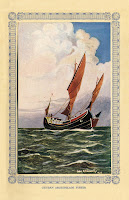Chinese Junks Remembered
Posted: February 17th, 2009 | 3 Comments »Now we can see them again in all their variety in the new reprint of Donnelly’s 1924 classic Chinese Junks a nd Other Native Craft from the Shanghai-based reprint publisher Earnshaw Books. In his introduction to the reprint Gareth Powell, a self-declared “Junk nutâ€, lays to rest the myths that Junks were somehow inferior sailing vessels – junks were easily handled by one sailor; their rigging was complex and they were superbly built and indeed have lasted better than any European ships of the Napoleonic era.
nd Other Native Craft from the Shanghai-based reprint publisher Earnshaw Books. In his introduction to the reprint Gareth Powell, a self-declared “Junk nutâ€, lays to rest the myths that Junks were somehow inferior sailing vessels – junks were easily handled by one sailor; their rigging was complex and they were superbly built and indeed have lasted better than any European ships of the Napoleonic era.
Donnelly’s book is full of his lavish illustrations – watercolours and sketches – that allow you to better appreciate the difference between a Yentai Trader and Tsungming Cotton Junk. You’ll probably never need to do this but you can appreciate that Junks came in a wide variety of sizes – his painting of a Foochow Pole Junk or a Chinchow Trader reminds us that they had high sterns, elaborate riggings and could be up to 180 feet in length.
The Junks are gone now – replaced by engined craft and the family-run barges that still crowd the inlan d waterways and canals of China. Junks were working boats and often appeared dirty and dishevelled to the amateur eye but as Donnelly reminds us in his beautiful little book – ‘Chinese Junks appear sorry looking craft – nevertheless the beauty is there.’
d waterways and canals of China. Junks were working boats and often appeared dirty and dishevelled to the amateur eye but as Donnelly reminds us in his beautiful little book – ‘Chinese Junks appear sorry looking craft – nevertheless the beauty is there.’
Chinese Junks and Other Native Craft, Ivon Donnelly (Earnshaw Books) – US$25 – available at good bookshops around Asia or via the web – click here.

Paul , Graham contacted me having seen a post I put up on your blog a while back.I now have a copy of his edition to go with my first edition of my grandfathers book ! He has done a nice job.
Tony Banham
You stated that Junks are no longer in use… if so, where did they go? Is there a “junkyard” (no pun intended)? If so, how does one get in touch with them? Thanks.
There are a handful in use as tourist vessels otherwise motor power vs sail took over .You can find the tourist ones if you Google Chinese Junks .One or two enthusiasts have restored or built them and there is a thriving group of people who study and use “junk rig” sails on other vessels.